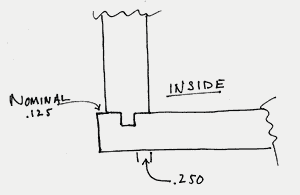Q.
We are a 32MM Euro shop and are looking to stretch a bit. I need some advice on frame cabinets with inset doors. What are standard rail and stile widths? What are the common attachment methods between frame and carcass? What overhang is standard? Are the top and bottom rails flush with the top of the carcass? Which part of the stile is flush with the carcass (or is any)?
Forum Responses
I don't believe there are any "standards" to speak of. That said, I'll try to offer some possibilities.
Stiles are often 1.5”, rails 1.5” as well. Mulls between doors are often 3” so that the reveal between pairs of doors is always the same. But there are no rules. Wall cabinet bottom rails might be much wider to accommodate under-cabinet lighting. Some shops pull the cabinets down from the ceiling to allow for wide crowns, some build a wide top rail and install as usual to eliminate any changes to doors and cabinet side length.
Inset doors with beads add another set of possibilities. You may find that some rail/stile widths are awkward looking once a bead is applied to the door opening. The gist is that there is no standard. Your aesthetic and shop methods will ultimately determine your decisions.
There are many ways to attach frames to boxes: butt, rabbet, dado, tongue and groove, biscuit. The most common is likely the dado. We used a t&g joint that worked well for us. The tongue was .25 x .25” and was set up .250” from the inside surface of the cabinet side. The tongue was machined on a dedicated shaper, face up so that the clearance between inside and tongue was consistent. The mating groove was machined on another dedicated machine running a .25” router bit .375” from the outside edge of the frame. That gave us a nominal .125” reveal - outside edge of frame to cabinet side face. If the cabinet side varied in thickness slightly (plywood varies) the reveal allowed for that.
Our frames were machined, sanded and sent out for finishing. Boxes were made from prefinished .75” veneer core birch and assembled after the frames were finished.
In our system, the top and bottom rails were flush with the sides and the stile was never flush except in some angled cabinets with exposed sides.
There are likely as many different (good) answers to your questions as there are cabinetmakers. The above worked well for us.

I would suggest 1 1/2 all around, simply because Conestoga and many other manufacturers use this dimension as a standard.
I assume since you have gained your expertise in frameless cabinetry, you don't have the machinery and equipment needed to properly and profitably build faces. If I am correct, you will find it's much simpler to just buy faces in your dimensions than buy material and machinery to make them. The goal is to offer a face frame cabinet, so if you buy your doors, it makes perfect sense to buy your faces as well. The lead time is the same and there's no need to stock 3 or 4 different species of wood for an occasional face frame since your forte will continue to rest on your 32mm expertise.